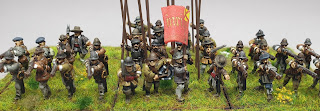Colonel Manus O’ Cahan’s Regiment of Foot
Captain Mortimer’s company of dragoons grew out of the Regiment: musketeers started being provided with horses for scouting and raiding parties, eventually becoming classed as dragoons in March 1645.
O'Cahan's was made up of seven companies which were formed along a sectarian divide: five companies of Protestants, and two made up of Catholics. This sectarian divide would provide grounds for confusion and inter-regimental fighting (and I don't mean not so friendly fisticuffs).
Shipped to Scotland in the first half of 1644 they fought at Kinlochaline Castle; Tippermuir, where they fielded 400 men; Aberdeen; Fyvie; raided Inverary; Inverlochy, there numbers down to 200 men; Auldearn; Alford; Kilsyth; literally meeting their end at Philiphaugh; those that managed to flee Philiphaugh met their end at the siege of Inverness.
Philiphaugh saw the end of most of the Irish Brigade: with the collapse of the Royalist cause in England, Leslie's Covenanting army returned north to deal with Montrose. Montrose's Army was camped in two separate locations - the force led by O'Cahan and the other Irish divisions who had stayed with Montrose found themselves under surprise attack and hopelessly outnumbered. Montrose tried to go to aid the beleaguered Irish but was fought back and fled.
Leslie offered O'Cahan terms of surrender: If they laid down their arms and agreed to leave Scotland, they would be allowed to go free. O'Cahan agreed. Leslie captured the now unarmed force, and O'Cahan witnessed the execution of virtually his entire army including the camp followers. O'Cahan and Thomas Laghtnan were taken to Edinburgh Castle and hanged from its South Wall without a trial.
As with the other regiments of the Irish Brigade, we know about some of their flags but not which regiment carried which flag: so I picked one at random. Thankfully I ordered correctly with this regiment and selected 'Irish pike open hand' so no cutting pikes off this time. Annoyingly I still had to drill hands out as despite being described as open hand, their hands aren't. This task is much easier to achieve with the 'open hand' pack than the 'with pikes ' pack but I'd still rather have open handed pikemen who don't need their hands drilling out. There are a handful of lowland Scots, and a few headswaps to make them look a bit more exciting.
Here endeth the Irish Brigade painting.
The Regiment is re-enacted as part of the Sealed Knot's Scots Brigade
Update: since discovering the primary source material for the Catholic Confederacy flags (see here) I've reflagged the regiment. Here's what they look like now...
















Hello I was wondering where you get your pike/spears from I can only seem to find the larger pikes online and I think these look to thick
ReplyDeleteI've always got mine from Donnington Miniatures, pack EQ10. Normally listed under 'Donnington new era' 'equipment', but they aren't listed on their website at the moment. They do have 40mm ones listed though EQ8 and EQ9.
DeleteThere was a change of supplier earlier this year - the new ones not quite as nice as the old style (the new leaf point is considerably more pronounced and needs a bit of slimming down) and made from a different wire.
Nick at North Star stocks wire spears, not sure what diameter wire his are though - I'm sure an email would soon provide you with an answer. The Donnington ones are 1mm.
Thanks, I’ve noticed that a few sites have listings but no stock, I’ve just started a ECW army using the Peter Pig miniature’s and would like to do what you do. Have not painted 15mm for many a year a little slow at the moment so next year taken care of :) keep up the good work you are inspiring me
DeleteGood luck with the project. The PP figures really lend themselves to block painting and washes. I don't consider myself a great painter but I think my results are pretty reasonable.
Delete